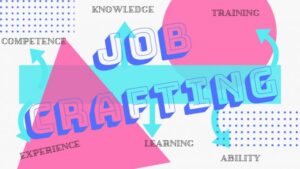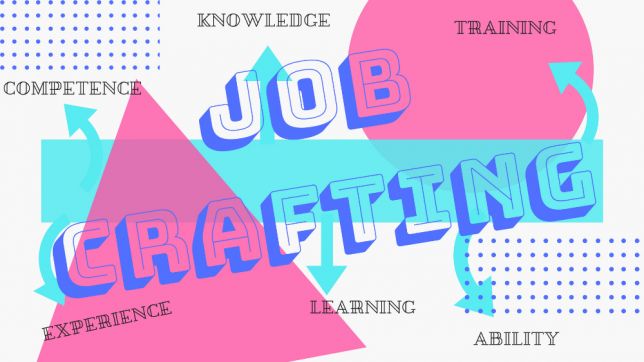 My last post before two-years break was about job crafting. This topic appeared as a theoretical issue during one of the national scientific conferences on organizational psychology in which I took part. At the beginning of this month I was at an international conference in which research on job crafting and its variations (social crafting, leisure crafting, boundaries crafting) were so often presented that even it began to be joked about that among participants. Therefore, I decided to raise this subject again, albeit from a different perspective. Two years ago, I wrote about the original job crafting concept by Amy Wrzesniewski and collaborators, this time I will present the individual job redesign model by Maria Tims und Arnold Bakker based on job demands-resources model (JD-R) by Evangelia Demerouti.
My last post before two-years break was about job crafting. This topic appeared as a theoretical issue during one of the national scientific conferences on organizational psychology in which I took part. At the beginning of this month I was at an international conference in which research on job crafting and its variations (social crafting, leisure crafting, boundaries crafting) were so often presented that even it began to be joked about that among participants. Therefore, I decided to raise this subject again, albeit from a different perspective. Two years ago, I wrote about the original job crafting concept by Amy Wrzesniewski and collaborators, this time I will present the individual job redesign model by Maria Tims und Arnold Bakker based on job demands-resources model (JD-R) by Evangelia Demerouti.
The JD–R model (Demerouti et al., 2001) assumes that every work environment has its own characteristics, which can be seen as demands or as resources. Job demands refer to those physical, social or organisational aspects of the job that require sustained physical or mental effort and are therefore associated with certain physiological and psychological costs. Job resources refer to those physical, psychological, social or organisational aspects of the job that, (1) may be functional in achieving work goals, (2) may reduce job demands and the associated physiological and psychological costs and (3) may stimulate personal growth and development. As research showed, not all job demands have negative effect on job performance. That’s why Anja van den Broeck and colleagues (2010) divided them into two categories: challenging demands and hindrances demands. Job challenges are demands that are stimulating despite they require some energy (e.g. time pressure, workload). Job hindrances are health-impairing job demands that hinder optimal functioning (e.g. role ambiguity, interpersonal conflicts, job insecurity). How does this relate to job crafting?
According to Tims and Bakker (2012) employees can change their levels of job demands and resources to adapt them to their own skills and preferences.
For this purpose an employee may:
- increase the level of job resources: structural (e.g., autonomy and variety) and social (e.g., social support and feedback) available at work,
- increase the level of challenging demands at work,
- decrease the level of hindrance demands at work.
In this case job crafting will be understood as the changes that employees initiate to modify their levels of job demands and resources. All of this should lead to higher level of work engagement, job performance and job satisfaction. Is it so in reality?
As the research conducted by Tims, Bakker and Derks (2013) showed, an increase in job resources mediated the relationship between employee job crafting and increased well-being. Crafting job demands did not result in a change in job demands, but crafting challenging demands had an impact on increased engagement and decreased burnout of employees. Also most studies on job crafting presented during the mentioned conference demonstrated the positive effect on work engagement and other positive outcomes. However, if the researchers introduced interventions, e.g. in the form of a workshop or web-application to bring employees closer to the job crafting concept and to facilitate this task, it turned out that it did not have a significant impact on the increase of employee engagement or other positive effects.
My conclusion from this is that work design only has positive effects if it happens on the employee’s own initiative. Hence good practice for managers will be to give employees more freedom in terms of how they will do their job and under what conditions they will do it, instead of putting pressure on them to change something in this regard.
Source: Demerouti, E., Bakker, A.B., Nachreiner, F., & Schaufeli, W.B. (2001). The job demands-resources model of burnout. Journal of Applied Psychology, 86, 499–512.
Tims, M., & Bakker, A. B. (2010). Job crafting: Towards a new model of individual job redesign. South African Journal of Industrial Psychology, 36,1–9.
Tims, M., Bakker, A. B., & Derks, D. (2010). The impact of job crafting on job demands, job resources, and well-being. Journal of Occupational Health Psychology, 18(2), 230-240.
Van den Broeck, A., De Cuyper, N., De Witte, H., & Vansteenkiste, M. (2010). Not all job demands are equal: Differentiating job hindrances and job challenges in the Job Demands-Resources model. European Journal of Work and Organizational Psychology, 19,735–759.
Grafic credit: olx.pl

0 Comments